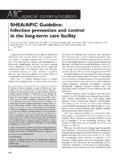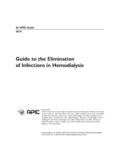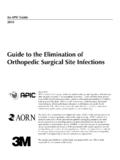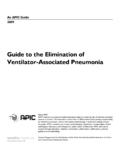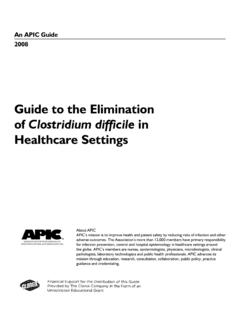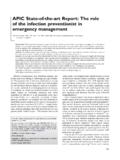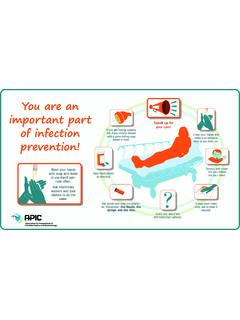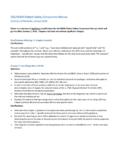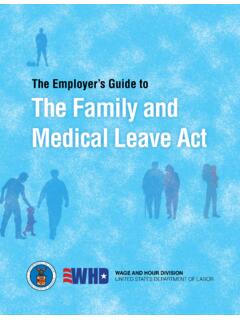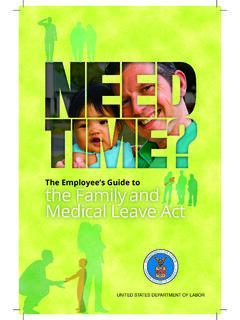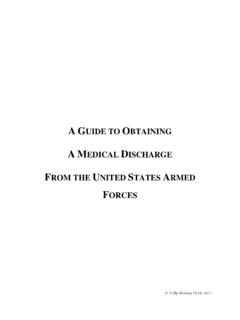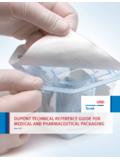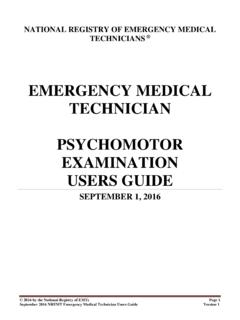Transcription of Guide to Infection Prevention in Emergency Medical Services
1 APIC Implementation GuideGuide to Infection Prevention in Emergency Medical ServicesAbout APICAPIC s mission is to create a safer world through Prevention of Infection . The association s more than 14,000 members direct Infection Prevention programs that save lives and improve the bottom line for hospitals and other healthcare facilities. APIC advances its mission through patient safety, implementation science, competencies and certification, advocacy, and data standardization. About the Implementation Guide seriesAPIC Implementation Guides help Infection preventionists apply current scientific knowledge and best practices to achieve targeted outcomes and enhance patient safety. This series reflects APIC s commitment to implementation science and focus on the utilization of Infection Prevention research. Topic-specific information is presented in an easy-to-understand-and-use format that includes numerous examples and tools. Visit to learn more and to access all of the titles in the Implementation Guide 2013 by the Association for Professionals in Infection Control and Epidemiology, Inc.
2 (APIC)All rights reserved. No part of this publication may be reproduced, stored in a retrieval system, or transmitted in any form or by any means, electronic, mechanical, photocopied, recorded, or otherwise, without prior written permission of the publisher. Printed in the United States of AmericaFirst edition, January 2013 ISBN: 1-933013-54-0 All inquiries about this Guide or other APIC products and Services may be directed addressed to:APIC1275 K Street NW, Suite 1000 Washington, DC 20005 Phone: 202-789-1890 Fax: 202-789-1899 Email: Email: DisclaimerAPIC provides information and Services as a benefit to both APIC members and the general public. The material presented in this Guide has been prepared in accordance with generally recognized Infection Prevention principles and practices and is for general information only. It is not intended to provide, or act as a substitute for, Medical advice, and the user should consult a health care professional for matters regarding health and/or symptoms that may require Medical attention.
3 The Guide and the information and materials contained therein are provided AS IS , and APIC makes no representation or warranty of any kind, whether express or implied, including but not limited to, warranties of merchantability, noninfringement, or fitness, or concerning the accuracy, completeness, suitability, or utility of any information, apparatus, product, or process discussed in this resource, and assumes no liability to Infection Prevention in Emergency Medical ServicesAssociation for Professionals in Infection Control and Epidemiology 3 Table of ContentsAcknowledgments ..4 Declarations of Conflicts of Interest and Disclaimer ..6 Introduction ..8 Section 1: Guide Overview ..9 Section 2: Epidemiology and Pathogenesis: Infectious Diseases in EMS ..12 Section 3: Risk Factors/Risk Assessment in EMS ..23 Section 4: Surveillance ..28 Section 5: Engineering and Work Practice Controls and Personal Protective Equipment ..32 Section 6: Occupational Exposure Health Issues.
4 43 Section 7: Bioterrorism and Infectious Disease Emergency Preparedness ..65 Section 8: Education, Training, Compliance Monitoring, and Summary ..71 Appendix A: Sample Ambulance Cleaning Procedures ..78 Appendix B: Sample Exposure Control Plan ..80 Appendix C: Definition of Terms ..83 Appendix D: Acronyms and Abbreviations ..86 Guide to Infection Prevention in Emergency Medical Services4 Association for Professionals in Infection Control and EpidemiologyAcknowledgmentsLead AuthorJanet Woodside, RN, MSN, COHN-SEMS Program Manager, Portland Fire and Rescue, Portland, ORAuthorsTerri Rebmann, PhD, RN, CICA ssociate Professor, Institute for Biosecurity, Saint Louis University, School of Public Health, Saint Louis, MOCarolyn Williams, RN, BSNO ccupational Health/Infectious Disease Program Manager, City of Portland, Portland, ORJeff Woodin, NREMT-P, FAHAT ualatin Valley Fire and Rescue, Tigard, ORResearch AssistantMartin B. SchoppEMS Intern, Portland Fire and Rescue, Student Nurse, Concordia University, Portland, ORReviewers Linda Bell, MSN, ARNP, EMT-PPrograms Coordinator, Consultant Services , Middleburg, FLGreg Bruce A-EMCACHICA-Canada, Platoon Supervisor/ Infection Control Officer, County of Simcoe Paramedic Services , Ontario, CanadaWilliam E.
5 Coll, BA, MPUB AFF, LP, REHSC linical Commander/ICO, Austin/Travis County EMS, Austin, TXJeffrey D. Ferguson, MD, FACEP, MS-HES, NREMT-PAssistant Professor of Emergency Medicine, Medical Director, Vidant Medical Transport, Assistant EMS Director, Pitt County, NC; Brody School of Medicine, East Carolina University, Greenville, NCLouis Gonzales, BS, LP System Coordinator Performance Improvement and Research, Senior Science Editor, American Heart Association, Office of the Medical Director, Austin/Travis County EMS system, Austin, TXGuide to Infection Prevention in Emergency Medical ServicesAssociation for Professionals in Infection Control and Epidemiology 5 Arthur Mata Medical Coordinator, Training Division, City of Flint, Michigan Fire Department (Retired), National Fire Academy Instructor EMS Katherine H. West, BSN, MSEd, CIC Infection Control/Emerging Concepts, Manassas, VAProduction TeamManaging EditorThomas Weaver, DMDD irector, Professional PracticeAssociation for Professionals in Infection Control and Epidemiology, Management and Production OversightAnna CongerSr.
6 Manager, Practice ResourcesAssociation for Professionals in Infection Control and Epidemiology, Meredith BechtleMaryland CompositionCover DesignSarah VickersArt DirectorAssociation for Professionals in Infection Control and Epidemiology, to Infection Prevention in Emergency Medical Services6 Association for Professionals in Infection Control and EpidemiologyDeclarations of Conflicts of InterestLinda Bell, MSN, ARNP, EMT-P, serves as national faculty for the American Heart Association (AHA), serves on the AHA Task Force #3 Committee, and is owner of Community Training Center through AHA. Greg Bruce, A-EMCA, has nothing to E. Coll, BA, MPUB AFF, LP, REHS, has nothing to declare. Jeffrey D. Ferguson, MD, FACEP, NREMT-P, has nothing to Gonzales, BS, LP, has nothing to Mata has nothing to Rebmann, PhD, RN, CIC, has nothing to Schopp has nothing to Williams, RN, BSN, has nothing to Woodin, NREMT-P, FAHA, has nothing to Woodside, RN, MSN, COHN-S, has nothing to H.
7 West, BSN, MSEd, CIC, has nothing to to Infection Prevention in Emergency Medical ServicesAssociation for Professionals in Infection Control and Epidemiology 7 DisclaimerThe Guide to Infection Prevention in Emergency Medical Services is advisory and informational and is intended to assist and Guide EMS agencies, including Public Safety and Fire, in providing a safe workplace through effective Infection Prevention programs adapted to the needs of EMS system responders. Although many regulations are introduced in this Guide , each EMS agency should be familiar with, implement, and comply with state and federal regulatory requirements. It is the intent of APIC to enhance access of Infection Prevention information through the content, references, and resources contained within this Guide . Resources are continuously being updated, and APIC has made every effort to present the most current information, including information maintained by other public and private organizations.
8 This information is useful; however, APIC cannot guarantee the accuracy, relevance, timeliness, or completeness of information developed from outside sources. IntroductionEmergency Medical Services (EMS) system responders deliver Medical care in many unique and oftentimes dangerous environments. They render care to increasingly mobile populations who potentially have a higher likelihood of having an infectious or emerging disease. In addition to treating accident victims of every nature (vehicular, falls, cuts, burns, and more), they treat the homeless, nursing home patients, trauma victims, and the critically ill with multiple diseases and infections. They have unique concerns such as suspect searches, communal living arrangements, and the need to clean and disinfect their work equipment. Like many other healthcare professionals, they face ever-increasing exposures to infectious diseases. Many of the agencies that employ EMS system responders are not hospital-based and therefore may not have the same knowledge of the importance of Infection Prevention as healthcare facilities.
9 Many EMS agencies lack funding and have limited staffing. Infection Prevention resources exist, but they are not easy to find. Resources for EMS system responders, such as the United States Fire Administration Guide to Managing an Emergency Service Infection Control Program (2002) and Infectious Diseases and the Fire and Emergency Services (2001), are out of date and many changes have taken place since they were published. APIC saw a need to develop this Infection Prevention Guide because EMS agencies, including public safety and fire, needed a comprehensive, easy-to-use Guide to serve as a resource to develop or enhance their current knowledge of Infection Prevention strategies. The information contained in this Guide is intended as a roadmap to develop a comprehensive Infection Prevention program. For the purpose of this Guide , all EMS personnel will be referred to as EMS system responders. This group encompasses all paid and volunteer paramedics and Emergency Medical technicians (EMTs) on ambulances, first responders, fire paramedics and firefighter EMTs, police, and public safety officers.
10 Although most EMS issues are similar, there are some differences among EMS system responders. Every effort has been made to address those differences. This Guide to Infection Prevention in EMS is intended to assist in keeping EMS system responders and the patients they care for safe and healthy while reducing their exposure to Infection Prevention in Emergency Medical Services8 Association for Professionals in Infection Control and EpidemiologyPurpose and scopeThe purpose of this Guide is to provide Emergency Medical Services (EMS) system responders and their organizations with a practical resource to Infection recognition and Prevention in the EMS environment. This Guide contains current information, recommendations, regulations, resources, program examples, and forms to utilize in the EMS system responder setting. Key concepts Infection preventionists (IPs) are healthcare professionals who have special training in Infection Prevention and monitoring.
